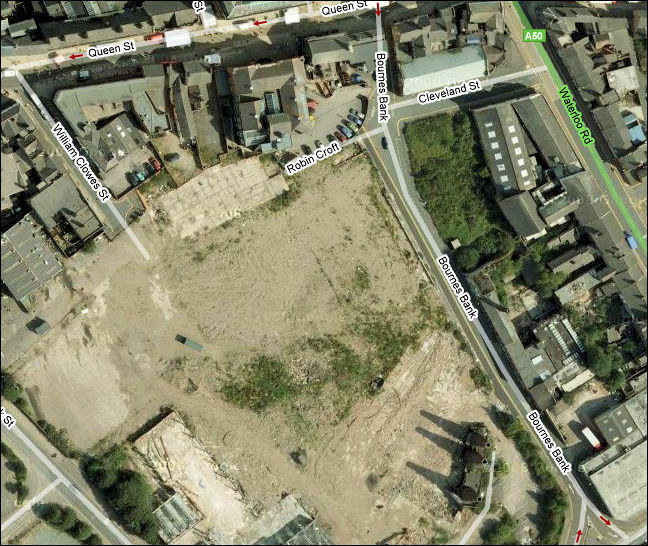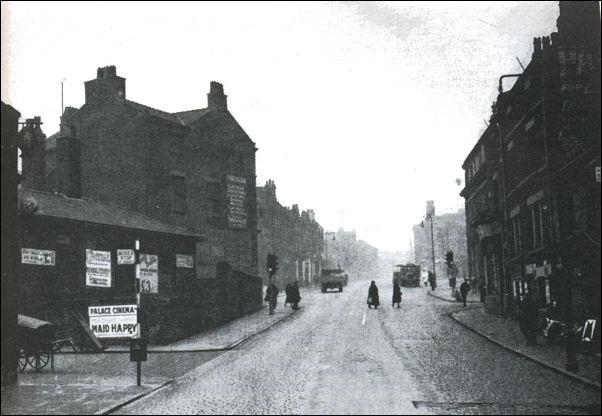|
Bournes Bank, Burslem
  
click the
"contents" button to get back to the main index & map
next: Moneto
House, Ricardo Street,
Dresden
previous: Old Town Road, Hanley
|
Historian Fred Hughes
writes....
Bourne’s
Bank looks as though a bomb has hit it. You certainly wouldn’t choose to
walk through its abandoned dereliction unless you had to. It feels risky
for there are no places to take comfort or respite and no fellow
travellers to turn to for companionship. This deserted Burslem lane
resembles a ruined war-zone from which all survivors have fled leaving its
last few crumbling buildings as nests for rodents and dumps for
fly-tippers.
“And
yet this was once one of Stoke on Trent’s most important roads,”
says historian Steve Birks. “It began life as a gateway to a medieval
settlement situated around St Johns Church, and was probably a
single-track lane leading to the top of the hill where Burslem is today.
By the early 1600’s the lane had become the principal approach as well
as a distinct packhorse route through the new town centre. It also
carried the main highway to Hanley until Waterloo Road was opened in
1817. The original name was Church Street until 1832 when it became
Bourne’s Bank. In 1812 a more direct route to the church, called New
Church Street, was built from St John’s Square. This is now William
Clowes Street.”

Google map of Bournes
Bank - April 2008
Although it is a thoroughfare less than a quarter of a mile long,
Bourne’s Bank was a recognized stagecoach route. An inn called the Royal
Express, after a coach-service that stopped there, provided stabling and
hospitality for London-bound travellers. In the 1940’s this pub was
nicknamed the Jig Post. No one knows why, but it was popular with American
servicemen who found some solace there in the company of what the
Potteries’ artist Arthur Berry called Shilling Women.
|
“Aside
from these tentative pastimes Bourne’s Bank grew to become the
Cultural Quarter of Burslem,” Steve assures me. “Shops and pubs and
cinemas linked-up in abundance. The Burslem Picture Palace on the top
corner was converted from a skating rink in 1911. According to the film
historian Barry Blaize, it was the largest and most comfortable cinema
in the Midlands accommodating 1,200 patrons on velvet tip-up seats. On
the opposite corner was the Coliseum Music Hall which was also converted
into a cinema during the 1920’s.”
The
cinemas at the top of Bourne’s Bank also shared space with Burslem
School of Art which opened in 1907. The centre’s assistant manager Peter
Harrison, age 53, recalls being taken to the Coliseum by his elder
sisters when he was five.
“I
remember it clearly because it was a special occasion,” says Peter. “It
was a Saturday morning sixpenny-show for kids and a very exciting western
action film was playing. But oddly the most vivid image I have of that day
was when we came out. Just down the bank from the cinema was a pottery
colour works and the workmen were sitting outside on the pavement having a
snapping break. I was puzzled when I saw their faces completely coloured
by the paint they worked in. It was as though they were from another
country or even another planet.”

Waterloo Road looking
up to Swan Square
to the left is a poster for the
Palace Cinema
the street is Cleveland Street which leads into Bournes Bank
photo: Warrillow
Collection
|
In the
meantime the Jig Post had become a nightclub in the late 1960’s.
There’s no doubt that Caribbean-influenced music was playing its part in
local social cohesion.
“A
growing black community wanted to exchange cultural recreations with white
residents,” says Rupert Scott age 64, a former owner of the Unity Club
later renamed Summerhouse. “We were looking for a place in the Potteries
to swing easy with soul and reggae music when we came across the redundant
Jig Post in Bourne’s Bank. There was already an established Burslem club
scene, and the town was a base for Stoke on Trent’s first black publicans
with Ozzie Clark at the Foaming Quart and Dave Moody at the American
Hotel.”
Rupert’s
former business partner Tom Distant also has personal recollections of
Bourne’s Bank.
“They
were happy times,” says Tom, also 64. “I played in a soul band called
Frankie and the Countdowns promoted by Dave Daniels who ran Stoke’s
Samantha’s Club. We were being compared to Hot Chocolate when Dave got us
on TV’s Opportunity Knocks, but we didn’t win.”
|
The famous pottery of Johnson Matthey also had its home in Bourne’s
Bank where gold-leaf was spun under royal patronage. The last pottery to
be demolished was Acme Marls a company that produced essential refractory
mixtures. All that is left of this notable company are three listed
bottle-ovens.
“Bourne’s Bank for the moment can be classed as a lost lane,” continues
Steve. “Everything that ever occupied its narrow undulating contours has
gone. And yet there is strong evidence that the current regeneration
policies are catching up. New work/live units have taken over the top
corner and hopefully that will spread towards the church through a new
housing project.”
Some of
these Bourne’s Bank units have been extended into the perimeter of the
School of Art finding a home for North Staffs Urban Vision as well as a
hi-tech sound studio called Urban Lizard. The school also provides
technical studios for the creative-vision company Junction15 owned by
partners Andrew Rownall and Darren Teale, two 26 year-olds who met at
Staffordshire University’s Media College. |
“It’s
been perfect for us to find such suitable accommodation in a location that
is bringing together a new community of working artists and creative
businesses,” says Andrew. “Although we are a national company this has
been our base since 2005. It’s great working in Burslem. And we’ve even
used Bourne’s Bank as a backdrop to a number of our productions. The road
is sympathetic to the requirements of a film-maker observing the past as
it merges with the present.”
Despite
the dereliction Steve is as impressed as Andrew with the potential
outcome.
“It is a shifting environment that has fallen into disuse caused by
industrial closedown and people’s changing preferences in leisure and
recreation. But who knows, one day soon Bourne’s Bank may be back on
track.”
 see
more on Bournes Bank
see
more on Bournes Bank |
![]()
![]()
![]()